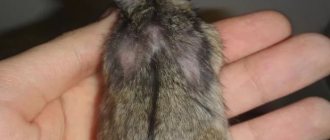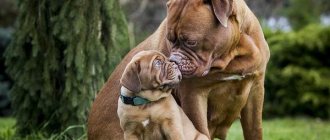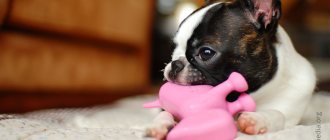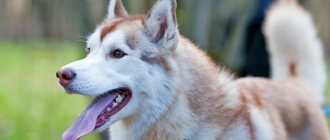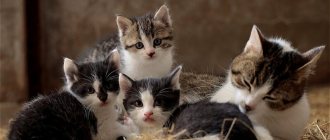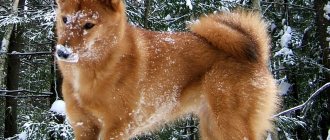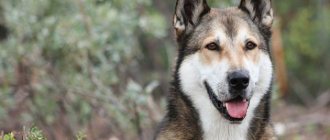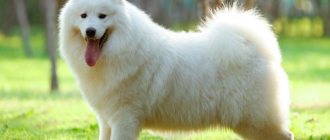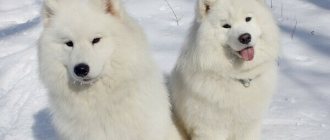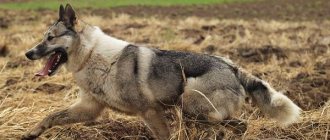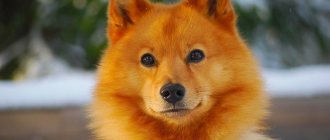16 minutes to read
A wolf hybrid is an exotic pet that not every dog owner can handle. A serious animal, with wild blood and an equally uncontrollable disposition, is not recommended for home breeding in many countries. In America, hybrids are considered wild animals. And in Russia, this breed is included in the “List of Potentially Dangerous Dog Breeds,” for which the law imposes special breeding and maintenance requirements.
Let's take a closer look at the hybrid of a wolf and a dog in order to clearly understand who we are dealing with - a domestic animal or a wild animal. Let's talk about the characteristics of the hybrid breed, the types of wolf-dogs, the features of their maintenance and upbringing. We hope that this information will help you assess your strengths and understand whether such a pet is right for you.
What is a wolf hybrid
Dogs evolved from wolves over many millennia. But these two species are related and are interfertile. This means that when these two species are crossed, viable offspring are obtained that are subsequently capable of reproduction. A dog crossed with a wolf is called a wolf dog or wolf hybrid.
A similar crossing occurs when two related species of animals are mated by chance or by plan: a wolf and a dog. Accidental mating is possible in the wild, when feral stray dogs mate with wolves. This happens, but not too often. Most often, a pair of dog and wolf is the result of the activities of breeders who cross these two species for the purpose of further sale.
Hybrids also include the offspring of a wolf and a wolf-dog, puppies born from two wolf-dogs.
Why do wolves and dogs mate in the wild?
Mixed breeding between a wolf and a dog in the wild is the result of mating between a male wild wolf and a female domestic dog. Such hybrids occur naturally, but are quite rare. This is because wolves have a highly developed sense of territoriality. They protect their property from encroachment by other species: feral dogs, coyotes.
Gray wolves most often interbreed with large domestic dogs - they are genetically closer to dogs than other wolf species. When does this mixing of species occur? If the wolf population declines sharply for some reason (1 individual per thousand km2), males are forced to look for a mate among other related species. This situation is possible if there is intensive shooting of wolves.
The second reason for the appearance of half-wolves in the wild is the encroachment of people into territories that historically belonged to wolves. That is, if wolves and domestic dogs live in close proximity, their crossing can produce wolf-dog hybrids.
Why are dog-wolf hybrids popular?
In some countries, a fashion has emerged for hybrid breeds. People willingly share photos of their massive semi-wild pets on social networks. To ordinary people, far from biology and genetics, it seems that you can have a pet that will look like a wild wolf and behave like a dog. This opinion is a mistake. A wolfdog is not a dog! A half-breed will never behave like a real house dog. Wild roots will always remind you of themselves. Keeping such a pet is difficult and not always safe; not everyone is up to the task.
Some people love the idea that they can tame a beautiful wild animal, tame it and bend it to their will. Hybrids are indeed very powerful and beautiful animals. They are strong and determined. But you shouldn’t get a pet just to touch the legendary semi-mythical image of a wolf. Such a decision must be balanced and responsible.
The irresponsibility of some owners leads to very sad consequences. People take half-bred puppies, and when they grow up and become wayward and difficult to manage, they are abandoned or euthanized. It’s good if the animal goes to a shelter where it will be taken care of. But not everyone is so lucky. In addition, a mixture of a wolf and a dog is an explosive mixture. Hybrids can be unpredictable and dangerous both for their owners and for others.
VOLAND - a new breed group of hunting huskies
WHERE IT ALL STARTED And it all began with a departmental kennel of hunting dogs that belonged to VNIIOZ. In 1974, an experimental mating of a she-wolf and a ZSL male was made for the first time. S.D. Voilochnikova wrote this article about the results of this experiment.
Some hunters, especially those who love to hunt large animals, try to get hybrids from a wolf and a husky. At the same time, they believe that such hybrids will not only be strong and hardy, but should also have a better sense of smell, hearing and vision than huskies. The possibility of obtaining hybrids from a wolf and a dog was known and used in the distant past. The Roman historian Pliny the Elder reported that the Gauls tied their female dogs in the forests so that they would mate with wolves. According to Prof. S.A. Gruner (1929), the peoples of northeastern Siberia and Kamchatka deliberately infused the blood of a wolf into a sled husky and the resulting hybrids were valued for their agility, endurance, ability to endure hunger for a long time and run long distances. The wolf as an improver appears to have been most frequently used in sled dog breeding. Improvement in the working qualities of hunting dogs through hybridization with the wolf also took place, although to a lesser extent. Radde (1862) wrote that hunting dogs very similar to wolves are not uncommon among hunters in East Asia, who assume that these dogs have an admixture of wolf blood and value them highly. About the possibilities of improving working huskies by hybridization with a wolf, N.A. Baikov (1927) wrote the following: “direct admixture of wolf blood, although it gives the offspring growth, strength, endurance and viciousness, but deprives it of those precious qualities that are so valued in a real husky: obedience , affection for a person and a clear voice. Therefore, all local industrialists prefer to cross their dogs not with wolves, but with distant descendants in the fourth and fifth generations.” Summarizing the available data on wolf-dog hybrids, we can assume that the first generation hybrids are not suitable for use in any work (service, hunting), since they are timid, willful, unbalanced and cannot be trained. Second generation hybrids are also not suitable, although among them there are some relatively docile and manageable individuals that can be used in further breeding work. In this regard, the question involuntarily arises: does it make sense to hybridize huskies with wolves when there are a number of clearly formed factory breeds in which there are many well-working dogs? And second, if hybridization of huskies with a wolf is desirable, then what exactly needs to be improved in huskies by infusing wolf blood? According to many observers, wild canids, including the wolf, have a more acute sense of smell, hearing and vision than domestic dogs. V. Guerre (1972) writes: “...although among dogs there are such narrow specialists as bloodhounds, even their heightened sense of smell cannot be compared with the multifaceted sense of smell of wolves...” The more acute sense of smell, hearing and vision of a wolf, obviously due to the better development of those parts of the brain where the corresponding centers of these sense organs are located. The relative weight of the brain in wolves is 30% greater than in dogs, and in wolves those parts of the brain that receive information from the senses are most developed. And the sense organs themselves - eyes, ears, nose - are better developed in wolves than in dogs (Gerre, Ziemen, 1972). We believed that in addition to a more acute sense of smell, vision, and hearing, it would be nice to convey to the huskies some other properties of the wolf, such as caution and distrust of strangers. Most huskies are known to be friendly towards people. This behavioral trait brings a lot of anxiety to owners and is one of the reasons for the loss of dogs. Thus, by infusing wolf blood into huskies, we had the opportunity to obtain lines of huskies with valuable properties. However, without carefully conducted experiments it was premature to say anything definite in this regard. Experiments on wolf-husky hybridization and observations of them were started at the VNIIOZ nursery by scientific director A.T. Voilochnikov. In the spring of 1974, four hybrid puppies were born from the tamed she-wolf Naida, taken as a puppy from the den and raised by a hunter: three males and a female. Their father was a 13-year-old West Siberian male Rex 1349/ls, rejected from the VNIIOZ kennel, who had an excellent exterior, gray “wolf” color and a height at the withers of about 60 cm. In terms of hunting properties, Rex was a typical animal husky. While baiting a decoy bear, he boldly worked on the animal. Many of his children also worked well on large animals. The hybrid female Ulka, taken from the she-wolf Naida at the age of 68 days, was purchased by the VNIIOZ nursery and raised there. Ulka looked like a wolf, both in color and shape, and often held her tail in a ring. Despite all our efforts, we could not achieve any noticeable domestication of Ulka. She remained timid, distrustful not only of strangers, but also of the huntsman who constantly dealt with her. She was never released freely into the forest, so it is impossible to say anything about the behavior of this hybrid in relative freedom. Sometimes at night she howled like a wolf, and one winter, wolves approaching the nursery responded to her howl. Ulka didn’t know how to bark; you could occasionally hear her “chuckling.” Of Ulka's brothers, we only knew about one. Raised in the countryside, he walked freely around the village and came to the call of his owner. At the age of two he killed 37 sheep. The owner, attached to the hybrid, having paid for the sheep, continued to keep it. But later it still had to be destroyed, since it continued to crush domestic animals. Ulka's first heat began in January 1976, at the age of 1 year 8 months. Ulka was covered by a West Siberian male Samur, light red color, large in stature, with an excellent exterior. After 64 days of pregnancy, she gave birth to a litter of two males and a female. While nursing the puppies, she repeatedly regurgitated the food they had eaten. It should be noted that Ulka had a strong attachment to Samur, the puppies’ father, who was kept in another enclosure. At every opportunity, she found Samura’s enclosure, came close to the net, rubbed against it and assumed poses of submission and “ingratiation.” This behavior was observed not only during the period of feeding the puppies, but also a year after their appearance. From Ulka's litter, a female named Buba was left in the nursery. The males were handed over to hunters. Buba was raised and kept in a city apartment from the age of 3 weeks. For the first weeks, she was almost inaudible during the day; she was either sleeping or lying quietly in a secluded place. At night she showed significant activity; during the first time she was in the apartment, she sometimes emitted a typical wolf howl. Until the age of 7 months, she met little with strangers, perhaps this was the reason that in the future she was afraid of strangers and, when they appeared, she hid under the desk and lay there, not moving, until the strangers left. Outwardly, Buba looked like a West Siberian husky, straw-red in color, she usually held her tail in a ring, but in front of strangers she lowered it like a log. Her head looked like the head of a pedigree West Siberian husky. Compared to huskies, she had better angulations of the hind limbs, elongated paws, and with such a build she had a typical wolf “springy” trot. Buba’s eyes, like the wolf’s, were yellow, only near the pupil there was a narrow ring of brown iris. She was very attached to the members of the family in which she grew up and loved my husband very much; when he left, she was bored and reluctant to go for walks. She lived in our family for 18 years. Buba was stubborn, self-willed and in most cases was uncontrollable. Everything unfamiliar caused her increased alertness, and in some cases, panic. She was especially afraid of rags fluttering in the wind. During the game, she exhibited movements and postures not observed in huskies. In the forest, Buba wandered quite far from her owners, but never lost them. She had a very good sense of smell, excellent hearing and vision. She was accustomed to shooting and would approach the barking of dogs she knew. In her presence, huskies repeatedly found and barked at squirrels, and she did not show any interest, but if she managed to grab a shot squirrel, she would eat the animal. No prohibiting commands stopped her.. In February 1979, from mating with the best sire of the kennel Serko 2822/ls, Buba gave birth to puppies; there were four females and a male in the litter. Three puppies were light gray and two were light red (all had small white markings on the ends of their legs and muzzle). During the period of feeding the puppies, as soon as any stranger appeared in the apartment, Buba immediately left her children and hid under the table, which was never noticed among huskies. The hybrids developed more slowly than the husky puppies, which appeared almost simultaneously with Buba’s puppies in the same apartment. Until 2 weeks of age, they were silent; they were most active at night. During the day, in most cases, they lay quietly, without leaving their place. Only at the age of 3 weeks did the hybrids begin to leave their corner and wander around the room. At the age of one month, their tails were curled into a tight ring, but their ears stood up much later. At the age of 1-1.5 months, Buba's puppies were handed over to fanciers. Their owners regularly reported to us about the growth and development of these hybrids, noting the puppies' calm nature, keen sense of smell, good hearing and vision. By the age of 6-7 months, many puppies had firmly grasped and carried out a number of commands well, good obedience was noted, the hunting instinct characteristic of huskies was manifested, they barked at wood grouse, squirrels, and looked for muskrats. Azoth, one of Buba's brothers, was raised in a small regional town and kept in a closed yard. His color was red with blackish-gray tones on his head and back. In general build he resembled a wolf. Azoth was very attached to his owners. He was regularly taken out into the forest and quickly came when called. According to the owner, Azot was distinguished by his intelligence, but at the same time he was wary, distrustful of strangers and was timid. This hybrid did not show any hunting properties. Gray, Buba’s second brother, did not differ in appearance from West Siberian huskies in either color or build. He was tall, 61 cm high at the withers, and had a red color with gray tones. His chest, neck, belly and legs were white. He was raised in the countryside and ran freely until he was 9 months old; only after he began to crush chickens, cats and attempted to crush goats, he was kept in an enclosure. Gray was very understanding and attached to his master, but he treated strangers with distrust and did not approach them, although he did not show any fear. At the age of about a year, Gray, together with a West Siberian husky, barked at a moose for the first time. After the elk left and the West Siberian husky began to silently pursue him, he remained in place and did not go after the elk. Subsequently, he repeatedly barked at the moose, sometimes chased them, but usually returned soon. At the age of two he was tested on a decoy bear. Gray was careful, but did not show cowardice and, persistently barking at the beast, attacked from behind and grabbed the gachas. In the spring of 1979, he was again tested by a decoy bear and again showed himself to be brave. In March 1978, from Gray and the purebred West Siberian husky Rumka, belonging to the VNIIOZ nursery, a litter of third generation hybrids was obtained, which included three males and a female. The male and female were left in the nursery, and two males were given to hunters for raising. All of Gray's descendants were raised and looked no different from purebred huskies, only some had light eyes (one hybrid from this litter had brown eyes). The hybrids raised in the nursery turned out to be more timid than those raised by hunters. Both recognized only people they knew well - the rangers and owners. They were wary of unfamiliar faces and did not approach them. The hybrids kept by the hunters were attached to their owners, knew a number of commands and carried them out well. From the age of 8-9 months they were taken hunting with huskies, and already at this age the hybrids showed good hunting properties. Thus, the hybrid Gosha (owner A.R. Sanovich, Kirov) at 10 months of age with a husky “put” an elk, which was killed. The hybrid Karat (owner V.V. Kayukov, Vyatskie Polyany) scared out game when hunting black grouse, quickly found escaped wounded animals, crushed them, but did not tear them. He actively searched for muskrats and minks, found and barked at martens. Gosha and Karat, according to the owners, had a much better developed sense of smell, hearing and vision than the huskies they owned. These hybrids were very energetic, bold in the forest and at the same time manageable. Having obtained hybrids of three generations, we could draw preliminary conclusions. The main one was that the wolf could be used as an improver of some properties of huskies. Hybrids had better sense of smell, hearing and vision than huskies, were attached to their owners, and were distrustful and wary of unfamiliar faces. Hybrids of wolves with West Siberian huskies of the first generation were essentially no different from wolves in terms of phenotype and behavioral properties. They are not suitable for hunting. The second generation hybrids were distinguished by great diversity in appearance. They were dominated by wolf behavioral properties. Among the second generation hybrids, individuals could appear that were quite manageable and limitedly suitable for hunting. The hybrids of the third generation were practically no different in appearance from the West Siberian huskies. Their behavior was largely formed under the influence of the environment in which they were raised and trained. If they were systematically dealt with, they became manageable, and a number of these hybrids showed hunting qualities characteristic of likes. Owners who had fourth generation hybrids noted their good sense of smell. hearing and vision, indicative reaction, not malice towards people and not cowardice. Our observations allow us to further call hybrids of the fourth and subsequent generations West Siberian huskies with an influx of wolf blood. These huskies have a four-generation pedigree certificate of origin. Outwardly, they do not differ from the Western Siberian huskies. In the conformation rings of regional and All-Russian exhibitions, they receive marks for conformation of “excellent” or “very good”, and if they have been trained from an early age, they show good hunting qualities, most of them have a tendency to work on large animals, some work well on boar game, squirrel, marten. In the process of many years of work, a breeding line was created, the ancestor of which was Gray (2nd generation), Gosha (3rd generation), Ayan (4th generation), part Gray 7287/lss (5th generation), Saigach 1982 /98 (6th generation) Tungus 5707/05 (7th generation). These sires had the highest marks for exterior, did excellent work on elk, wild boar, and bear, and staunchly passed on these qualities to inheritance. Among the descendants of Buba, the most outstanding are: champion of Bulgaria Samur (owner N. Radev), champion Barguzin 0925/95 (owner Marchuk A.G. Kirovo-Chepetsk), champion Bagira 5980/lzs (owner of the VNIIOZ nursery), champion Geida 0831/ 94 (owner V.A. Toropov, Orlov), etc. Thus, our materials allow us to assert that using absorption crossbreeding methods, the wolf can be used as an improver of some properties of huskies. But breeding hybrids is a complex, labor-intensive task that requires appropriate conditions and a long time.”
S.D. Voylochnikova
In general, it all started in 1998. I bought it through S.D. Voylochnikova. male Lobo, who was a 7th generation hybrid from those hybrids that were bred at the VNIIOZ kennel. In Lobo's pedigree you can find Champion Gray 7287 Toropov V.A. - multiple Winner of Field competitions in boar and bear (he comes from the ancestors of the 4th generation Ayan 3826/ls Stepanova G.A.) and Zaira Voilochnikova S.D. (from Bagira No. 5980/ls and Vogul 3553/ls of the VNIIOZ nursery). I would like to dwell on this dog in more detail. Gray VPKOS No. 7287 was an outstanding working dog who perfectly passed on his working qualities to his children and grandchildren (Lobo). Gray worked well and had field diplomas not only in decoy species of animals, but also in free animals. Its owner, working as a game warden in one of the districts of the Kirov region, obtained from under it more than a dozen wild boars and bears, arranging commercial hunts for foreign tourists. All his dogs are descendants of Gray, i.e. hybrids of wolf and WSL of different generations. As the owner of these hybrids himself said: “Gray is a thinking dog. He does not grab the animal thoughtlessly, but when he needs to stop it, but in such a way that he himself does not get hit again.” Although, of course, he came under attack and was stitched up more than once. Gray passed on his unique working qualities, inherited from his ancestors, well to his descendants, and in particular to his son, the great-grandfather of the current generation of hybrids - Saiga 1982/ls Toropova V.A. Saiga has several diplomas for the animal, including a 2nd degree diploma for free elk, and a diploma for free wild boar. 2nd degree. As Toropov says, Saigach began working early, was repeatedly cut by wild boars and was stitched up. At wild boar competitions, he repeatedly inflicted wounds on baited pigs that were incompatible with life, and after such “work” of his, they died. A distinctive feature of Gray, Saigach and other Toropov hybrids in working with wild boar is their strong grip on the animal’s groin area, so strong and so precise that they often tear out the genitals of their victim. When I heard this from Toropov, it wasn’t that I didn’t believe it, but let’s say, I treated his words with distrust, until suddenly, unexpectedly, after a while I saw the same manner of work in my dog (Saiga’s son, Lobo). Obviously, this manner of work is a distinctive feature of the work, inherited from the wolf, which kills its prey in exactly this way: a wolf pack surrounds the animal (elk, wild boar); some distract from the front, trying to grab the muzzle, others grab exactly these places, because there are vital arteries and large nodes of nerve endings. This leads the animal to first go into painful shock, and then it dies, slowly bleeding out. The traditional work of huskies is such that grips are usually made on the “gacha” and soft places, but not with the aim of causing injury, but with the aim of causing pain and thereby stopping the animal before the owner arrives, i.e. the hunter who “makes the end” with a shot. In simple terms, the husky works “for the owner.” The wolf does not expect help from humans - it tries to kill its prey itself. This is where the whole difference lies. The same working qualities that Gray and Saigach had were also evident in Lobo, the grandfather of the 2nd generation hybrids. I would like to note Lobo’s fighting qualities, since he is the “cornerstone”, let’s say, dog from which the second round of hybridization began, a new “wolf line” began in modern domestic hunting dog breeding. This is a strong male above average height, almost white, light fawn color, with a well-stretched body (104) and beautiful hind legs, (unlike most of the square, straight-backed dogs that now flood the West Siberian Laika population), full-toothed, again in contrast from the majority of “oligodonts” available both in the Samara region and throughout Russia (incompletely toothed dogs that lack P1, P2, and some even P3(!), which even have Champion titles!!! But let the dishonesty of experts remain their conscience). Moreover, what is extremely important, he perfectly passes on his “full teeth” by inheritance, and even when mated with “incompletely toothed” bitches, the puppies are born with a full set of teeth and without defects or flaws, speaking in canine language, Lobo is a prepotent male that improves many shortcomings and the vices of their bitches. However, he would be worthless if he were not an excellent working dog. He was brought to the baiting station for the first time when he was barely 1 year old. Lobo proved himself well in the first wild boar hunt, working viciously and assertively, with strong painful grips. He managed to anger the decoy cleaver (a well-known half-breed cleaver at the station, who had crippled and mutilated more than one good dog) and he, having driven him into a bush, dealt strong chopping blows with his fangs to the ribs under the shoulder blade, after which the dog had to be stitched up in a veterinary clinic and then for a long time, more than a month, to nurse, because the seam came apart and the wound festered. The dog almost died. However, all this happened later, but that day, even with such severe bleeding wounds, almost immediately after baiting the wild boar, he managed to do an excellent job on the badger for a 1st degree diploma. Seeing this animal for the first time, he immediately took it in its place (by the neck) and almost strangled it, so much so that the huntsmen and the owner had to forcibly snatch the badger from him, unclenching his teeth with a stick like a pit bull terrier. No one expected such brilliant work from a one-year-old dog who had just been wounded by a cleaver. Lobo has a 1st degree diploma in marten and works well on squirrels, although the owner does not welcome this, focusing on working on large animals. One night I worked on a marten for two hours while I went to get a gun and approached it in deep snow. The funniest thing was when I was stuck waist-deep in snow in a ravine, and he barked, barked, called me, called me, then came up to me and looked... He didn’t say anything... He left... And then I heard: he’s chasing her towards me! This was the most interesting trick on his part! And I took it off without getting up. It still remains a mystery to me: how did he manage to drive her to me, or drive her towards me? This is simply amazing and inexplicable to me to this day. After all, he came up and looked at me, saw that I was stuck and tired, somehow digested it all in my head and made the only right decision: if the mountain does not go to Mohammed, then he needs to drive “This mountain”! Maybe all this is just a coincidence, but the fact is a fact: the marten came running on horseback right to me. Lobo works well in ducks from the age of 6 months, and he passes this quality on well to all his descendants. I won’t list everything, I’ll just say that I have repeatedly observed how strikingly different the work of hybrids is from purebred huskies. When working on a badger, our hybrids try to catch the badger from below by the throat, because if you take a badger from above by the neck, then it easily turns out on the “fat” and skin and bites and tears the dog from below with its claws. Anyone who has hunted a badger knows what a strong and tenacious animal it is, and that sometimes even three huskies cannot cope with it. The structure of a wolf's teeth is different from that of a dog. If you look at a wolf's fangs in cross-section, you will notice that they have two cutting edges (outer and inner), like a knife, while a dog has only one - the inner one. Therefore, wolf bites cause lacerations, similar to wounds from a knife. This fact is reflected in people's sayings, which is why they say that the wolf slaughtered the sheep, and did not kill it. And, of course, flair: no husky can compare with the flair of a hybrid, even the 8th or 10th generation. But this instinct often plays a cruel joke with the owner of the hybrid, because the love for carrion and shit, and also the desire to wallow in all this is so great that even if you hit your hand on a stubborn dog’s head, even if you break a stick on a stinking dog’s back - nothing will help, anyway, the next day he will find it somewhere again and again lie down and come back with a satisfied face, saying, “Smell it, enjoy it.” But there are also pleasant, albeit unexpected, surprises. So, for example, this happened once in the Volgograd region, when Lobo and I were on a walk outside the village. He suddenly lowered his head sharply and followed some kind of trail, and walked for about 2 kilometers, then he jumped into a ravine and stands happy, waving his tail and not barking, but as if saying: “WOW-WOW.” I'm approaching. I see a large bloody cellophane spread out, a bloody braid and 5 bloody tied bags. I really think, "Wow"! Can you imagine my bewilderment... Well, I think some village maniac has been at work... I untie one of the bags... And what do you think is there? A domestic one-year-old pig, cut into pieces along the backbone and bones... Village thieves stole a pig from someone at night and hid it. But to their misfortune, Lobo and I went for a walk in nature, and Lobo, like a real police bloodhound, found someone missing. And it turned out to be a good pig! My four-legged friend Lobo and I ate it for a whole month.” Now I will say a few words about the “new round of hybridization.” At the time of mating, the she-wolf Shelma from the zoo was 6 years old. This is the mating of Lobo and the she-wolf Shelma at the Samara Zoo
The history of the appearance of the wolfdog breed
The first mention of the crossing of dogs and wolves dates back to the middle of the 18th century. However, the deliberate practice of breeding wolfdogs began on Colorado farms in the 1950s. Then a group of enthusiasts, concerned about the decline in the wild wolf population, began crossing them with domestic dogs in order to somehow stop this process. Breeders crossed gray, red and Ethiopian wolves with large dogs: German shepherd, Siberian husky, Alaskan malamute.
Modern hybrids are not the first offspring of a wild wolf and a domestic dog. This is the result of crossing several generations of hybrid breeds with each other. Most purebred wolfdogs can trace their history back to those Colorado dog farms of the 1950s.
Description of the dog breed: wolf-dogs
Although each hybrid breed's conformation is unique, all wolfdogs have common traits. These are powerful, harmoniously built animals, resembling wild wolves in appearance. The “wildness” of half-wolves is noted in their movements, posture, gaze, grin and coat color.
These are strong animals with excellent health. They do not have many of the genetic pathologies that are observed in dogs that became the progenitors of the hybrid. Behind this “beauty of a wild beast,” which involuntarily attracts the eye, hides “animal habits.”
Characteristics of the wolfdog breed
The bestial appearance of half-breed wolves is not the only thing that hybrids have left from their forest parents. Mestizos absorbed the character of both wolves and dogs. But at the same time, due to the unnatural crossing of a wild predator and a completely domesticated dog, some characteristics were enhanced, while others were completely lost.
The more wolf blood flows in the veins of a hybrid, the wilder its temperament will be. This point should always be taken into account when deciding on choosing such a pet. The “animality” of the temperament also depends on how many generations separate your dog from the first wild ancestors.
Wolves mature much later than domestic dogs, so their full temperament is revealed at the time of puberty at 18 months. Half-breeds can show affection towards their family members, children and pets. But they still have wild instincts of predators, so it is unacceptable to leave children and pets alone with half-wolves.
From forest parents, hybrids inherited fear of man (anthropophobia), bestialism (hunting for livestock) and the habit of marking territory with their feces. It is unlikely that anyone would like such qualities of a pet.
In addition, a cross between a wolf and a dog can show strong aggression towards both strangers and members of its own family. So they try to win a higher hierarchical position from a person. Cases of wolf mestizos attacking humans are not uncommon. This undesirable characteristic is the most common reason pets are abandoned and brought to animal shelters.
Wolfdog of Saarloos
Czechoslovakian Wolfdog
How does a wolfdog puppy differ from dog puppies?
Until wolfdog puppies have reached sexual maturity, they can be mistaken for the offspring of an ordinary domestic dog. The striking features of hybrids appear after age-related changes in the hormonal background of the animal. However, even the smallest half-breed wolf cubs are different from dog cubs.
How can you understand that this is a half-breed puppy:
Breeds – hybrids of dogs and wolves
Wolamuth
The Volamute is a relatively recently developed breed by crossing the Alaskan Malamute and the Gray Wolf. Origin: USA. Hence the other common name for the Volamute – Alaskan Malamute hybrid. The breed is not recognized by the FCI.
Puppies even in the same litter can be very different from each other. In general, Wolamutes grow into fairly large individuals; males can weigh up to 79 kg. Externally, the dogs are very similar to their ancestors - pointed ears, wedge-shaped muzzle, white or gray coat with clearly defined dark and light markings.
Given the animal's size and strong hunting instinct, it is not recommended to leave them alone with children or the elderly.
- The character of Wolamut is lively and agile.
- These are very active dogs and require a fairly large space.
- Without proper intense exercise, dogs can exhibit destructive tendencies - digging large holes in the area, gnawing objects.
- In addition, territorial aggression or conflicts with other pets are not uncommon.
- To avoid unpleasant incidents, the puppy must be socialized from 4 weeks.
Wolamute puppies can be purchased in the USA, the price range is wide - from 150 to 3800 US dollars.
Wolfdog
The name wolf-dog is often used as a generalized concept for a cross between a wolf and a dog. If we talk about the wolfdog as a breed of wolf dog, specialists from the Military Institute located in Perm are mentioned as its creators. At the end of the 20th century, studies of the behavior and character of wolves were conducted on the basis of this institution.
The purpose of the study was the need to breed a service dog with enhanced olfactory qualities. At the same time, the hybrid had to have a high level of tolerance towards humans and unquestioningly follow commands. The task was completed, and as a result of crossing wolves and German shepherds, service dogs appeared, which border troops successfully use to protect the Asian borders of Russia.
The breed is not recognized by the FCI.
Wolf dogs are quite large animals, up to 70 cm tall and weighing up to 50 kg.
- Wolf dogs are distinguished by excellent health and significant physical strength, exceeding the power of German shepherds.
- There are legends regarding the wolf dog's sense of smell - the "wolf dog's" sense of smell allows it to pick up a scent for up to three days, while, for example, German shepherds lose this ability after 12-18 hours.
- Dogs are highly trainable, but require a confident, authoritative owner.
- Not suitable for family living.
Wolf-dog puppies can be purchased in private nurseries at a price of 15,000 rubles.
Kunming wolf dog
An experimental breed created by Chinese military dog handlers in the 50s of the 20th century. Kunming is the administrative center of the southern Chinese province of Yunnan. It was here at the army base that German shepherds brought from Europe were crossed with local breeds of wolves.
This is how the Kunming wolf dog with excellent search characteristics was created. In 1988 the breed was recognized in China. Kunming Shepherds, as they are often called, are involved in the rescue service, the police, and the penitentiary system. They have proven themselves excellent in patrol duty and searching for illegal drugs.
The breed is not recognized by the FCI.
The Kunming wolf dog has tremendous strength and endurance. It is slightly taller than a German shepherd - the height of a male can reach 70 cm. The weight of an adult male is about 40 kg.
- Representatives of this breed are unpretentious and loyal to humans, so babies are often bought as pets.
- Dogs are active, require intense aerobic training and are not suitable for people leading a sedate lifestyle.
You can try to purchase a Kunming puppy through the Chinese Canine Union, but there is no reliable information about the cost in open sources.
Wolfdog of Saarloos
Another version of a cross between a German Shepherd, this time with a wolf that lives in the Canadian forests. The experiment was carried out by the Dutchman Lander Sarloos, starting in the 30s of the last century. After his death, work on breeding a special breed was continued by his wife and daughter. Their efforts were crowned with success, and in 1981 the Saarloos wolfdog received recognition from the International Film Festival.
The standard is fixed and assigned to group 1, section 1 – Shepherd Dogs.
The hybrid turned out to be quite large, and this is true for both male and female individuals. The former can boast a height of up to 75 cm at the withers, the latter – up to 70 cm. The weight of the dogs reaches 42 kg.
- The main purpose of the Saarloos wolf dog is as a companion.
- They have an independent, but non-conflict character, and practically do not show aggression.
- They are loyal, have a calm disposition and are easy to train.
- Representatives of the breed have a strongly expressed instinct, inherited from a wild ancestor. Therefore, they are not used to perform official tasks.
- But mestizos do an excellent job as guides and participate in rescue operations.
The cost of a puppy is ~500-700 US dollars in foreign nurseries.
Greenland dog
The Greenland dog is a sled working dog, vaguely reminiscent of the Siberian Husky or Alaskan Malamute. Thick double coat with undercoat and a thick fluffy tail make it look like another breed - the husky. Indeed, the Greenland dog is often called the Greenland husky.
However, this is an independent, unique and very ancient breed. The origin of this breed is not known for certain, but studies have shown that on the coast of the Berengov Sea the breed crossed with one of the species of now extinct wolves. It is believed that the dog could have come to Greenland thanks to ancient people who traveled through the Arctic region.
The breed was recognized by the FCI in 1967, group 5, section 1 – Nordic sled dogs. An interesting fact is that it was Greenland dogs that allowed Amundsen to be the first to conquer the South Pole.
Medium-sized individuals - height from 60 cm, weight up to 30 kg.
- The Greenland dog is very sociable.
- Lively, active, with rich facial expressions, she is always friendly towards people and loves to be in his company.
- The pet makes a lot of different sounds when communicating - squeaks, barks, grumbling, whining and howling.
- It is considered a working dog and is not used as a guard dog.
The breed is not widely distributed outside of Greenland, so information on the cost of puppies is not available.
How to properly deal with half-wolves
To keep an exotic half-breed pet, you will need to create special conditions and learn how to handle them. Without certain knowledge of the physiology and psychology of mixed breeds, this venture may turn out to be a failure at best. And at worst, lead to serious irreparable consequences for both the pet and its owner.
These types are not suitable for home apartment maintenance. Throw away the idea of getting a wolf hybrid if you only have a city apartment to spare.
For content you will need:
- Lots of space away from other people and noisy highways. A farm somewhere in the forest is an ideal place to keep this breed. The following habits were passed on to the hybrids from wolves: howling loudly and constantly wandering. They need the presence of wildlife to explore. There they will not disturb their neighbors with their howling, and the noise from cars will not frighten the pets.
- The space in which wolves are kept must be at least 0.2 hectares per individual. This should be a securely fenced area with a high fence (2.5 meters) so that the animal cannot jump over it. And a deep concrete foundation so that the pet cannot dig under it.
- It is best to enclose the space for keeping hybrids with a double fence with teeth curved inward.
- It is necessary to ensure good soil drainage in the area so that animals can find dry areas in rainy weather.
- The booth is not suitable for keeping wolfdogs. It is necessary to build a spacious house with a high shelf so that the pet can occupy a position on a hill.
- Low-growing shrubs and trees should be planted on the site so that the animal finds shelter in the heat. It is unacceptable to plant tall trees near a fence - the pet may run away!
- The gates are installed high - 1.8-2 meters. Gate latches must be reliable.
Important: immediately evaluate your ability to create the right space for keeping wolf hybrids. If you are not ready to provide your pet with such conditions, give up the idea of getting a wolf-dog.
Are wolf-dog hybrids trainable?
Mixed breeds of wolves and dogs are naturally intelligent and quick-witted. But they are also stubborn, self-willed and very energetic. To keep your pet in good shape, you need 1 to 3 hours of physical activity per day. You need to walk them a lot and actively.
Let's look at the educational and training features of wolf-dog hybrid dog breeds.
- The offspring of wolves and dogs are more difficult to train. These puppies have stronger instincts and are ready to follow them.
- The person must immediately indicate to the pet that he is in the role of the alpha male. Weak owners will not be able to constantly maintain this position. The pet will always try to take a dominant position, expressing this through disobedience to the person, refusal to follow commands and demands.
- Half-breeds have a strong fear of new situations and people - this makes training difficult.
- Toilet training on the street causes certain difficulties. Wolves are accustomed to marking their territory with feces. When they defecate at home, it is a territorial instinct, not a protest.
- Wolf instincts and aggression can trigger at any moment. A pet can attack a child, another pet, livestock or bird.
Husky Wolf Mix – a hybrid of a Siberian husky and a wolf
How to feed breeds that are wolf-dog hybrids
Conventional dog food is not suitable for feeding hybrid breeds. The diet of such a dog should consist of fresh meat. The best options are wild game, elk, bison, beef, lamb, rabbit, chicken and turkey. Pork causes digestive problems and should be avoided.
The meat is given raw along with the bones. Bones are not a problem for wolf descendants. They do a great job with them. The descendants of wolves do not need cereals. Pets are given fruits, vegetables and fresh herbs as sources of vitamins and fiber. The area where the pet is kept must have grassy soil so that the animals can eat grass.
To compensate for the lack of vitamins and minerals, you need to give fortified supplements as prescribed by your veterinarian. Particular attention should be paid to access to fresh fresh water. It is best to organize a drinking trough on the site, similar to the kind they make for keeping livestock. During the hot season, it would be a good idea to place a children’s pool on the property so that your pet can drink and swim in it.
Dogs that look like wolves
Tamaskan dog
The Tamaskan dog, like other wolf-dogs, is very similar to a wolf . But, like the northern Inuit dog, it does not have “wolf blood” in its breed. The experiment was carried out in Finland with the goal of creating a family-friendly, friendly dog that looks like a wolf.
As a result of numerous crossings of various types of wolf-dogs, including the Northern Inuit, Alaskan Malamute, Siberian Husky, the attempt was crowned with success. The result was a wonderful pet with good working qualities.
The breed is not recognized by the FCI.
The Tamaskan dog is large, male height up to 71 cm, weight up to 45 kg.
- Representatives of the breed are patient, good-natured, and do not show aggression.
- They are very sociable and ready to cooperate, easy to learn.
- They get along well with children and other animals.
- Not recommended for keeping in an apartment.
- Also, residents of southern cities with mild climates should not get this dog.
- The pet will feel best when it has the opportunity to “work” in a harness in an open space.
- The ideal option is to keep two or more Tamaskan dogs in a large yard and free-range.
- Animals prefer to be in a pack.
The price of a baby Tamaskan dog in European kennels starts from 1200 US dollars.
Utonagan
An experiment similar to the Finnish one is being conducted in the United Kingdom. In the vastness of this country, cynologists crossbreed individuals of the Alaskan Malamute, Siberian Husky and German Shepherd. Selection work continues at the present time, but the main task was completed at the end of the 20th century.
The experiment was considered successful, since as a result, a surprisingly friendly animal was born, outwardly similar to a wolf, but with thicker, fluffy fur. And in 1996, a significant event occurred - a club of passionate lovers of this breed was established in England. Since then, animals have become widespread in the UK, Scotland, and later in Canada and the USA.
Utonagan is a tall and large dog, height reaches 73 cm, weight 50 kg. Males are traditionally larger than females.
- Pets have a calm, balanced character and are considered an ideal family companion.
- Utonagans are friendly, affectionate dogs that strive to communicate.
- They perfectly sense the mood of the owner and surprisingly easily adapt to his character and lifestyle.
- They are ideal for active people, as they are energetic, active, and love to have fun and play.
There are no nurseries in Russia, so you will have to go to the UK to get a puppy, where the cost starts from 800 US dollars.
Northern Inuit
The Northern Inuit is a dog resulting from crossing an Alaskan Malamute, a Siberian Husky and a German Shepherd . In other words, the northern Inuit dog does not have the genes of a pure wolf; mestizos of the named breeds were used to create it.
Initially, breeding work was carried out in Canada in the mid-80s, and the northern Inuit entered the territory of the Kingdom of England later. The purpose of the experiment was to instill “wild, wolf” qualities in a domestic animal.
The breed is not recognized by the FCI.
The size of the animal is impressive - males are found up to 81 cm in height and weighing up to 50 kg.
An interesting fact is that northern Inuit dogs are so similar to wolves that they are often used in cinema. For example, they can be seen in Game of Thrones.
Dogs are balanced and calm. They have a soft, obedient character.
It is very difficult to find Northern Inuit puppies in Russia; the price of a baby, including transportation from Europe or Canada, can reach 6,500 US dollars.
Advantages and disadvantages
To make it easier for you to form your attitude towards this hybrid of a wild predatory animal and a domestic dog, we have summarized all the information and highlighted the main pros and cons of the hybrid breed of dog and wolf.
Pros:
- high intelligence;
- strong attachment to the owner;
- endurance;
- high performance characteristics;
- unpretentiousness in food;
- excellent health;
- unpretentiousness to conditions of detention.
Minuses:
- a pronounced desire for dominance;
- cause fear in other people;
- do not strive to please the owner;
- require large space for maintenance;
- require long hours of physical activity;
- they like to dig, they can spoil plantings and destroy flower beds;
- constantly mark the territory with their feces;
- hunt livestock and other pets;
- suffer from anthropophobia;
- behavior is inconsistent and difficult to predict;
- extremely curious, can damage things, furniture, communications.
Why the breed is not recommended as a pet
Although there are examples in the world of successfully keeping pets that are a cross between a wolf and a dog, they are rare. Much more common are stories of keeping half-breeds that ended in tears. Therefore, all over the world, biologists and dog handlers are against the thoughtless and irresponsible ownership of such animals.
When a pet is kept in conditions inappropriate for its mental and physical development, there is always a risk to human safety. It is unacceptable to put a wolf-dog on a chain or lock it in a cramped cage - all this embitters the pet and makes it aggressive and dangerous to others. Every year thousands of half-blooded wolves die, whose owners were not ready to create the necessary conditions for their maintenance and care.
Owners ask veterinarians to euthanize their pets when they grow up and show a “wolfish disposition.” At best, animals can be saved if there is a shelter willing to take them in. Re-adopting such a pet into a family is very problematic. Compounding this problem is the fact that no rabies vaccine has been developed for the hybrid species. The usual vaccination against this deadly disease does not work on a cross between wolves and dogs.
Russian Wolfhund - black wolfdog, the largest of their hybrids
Mix of wolf and husky
